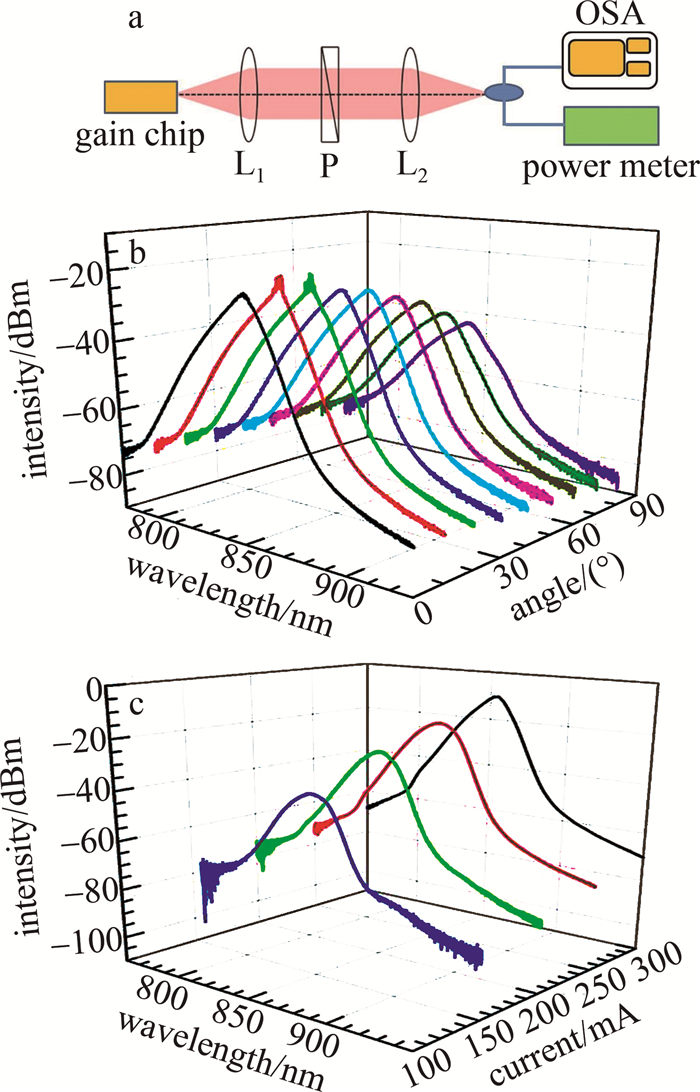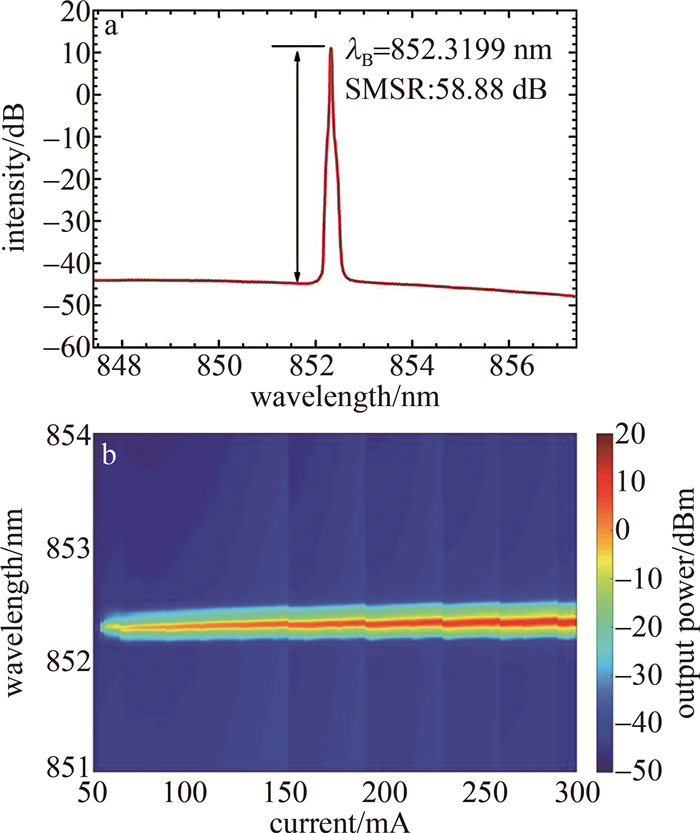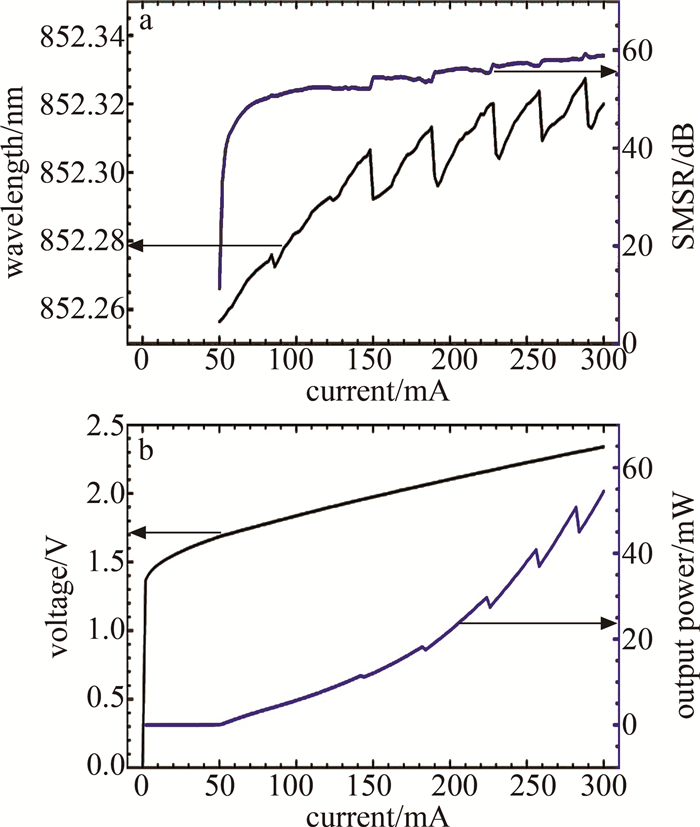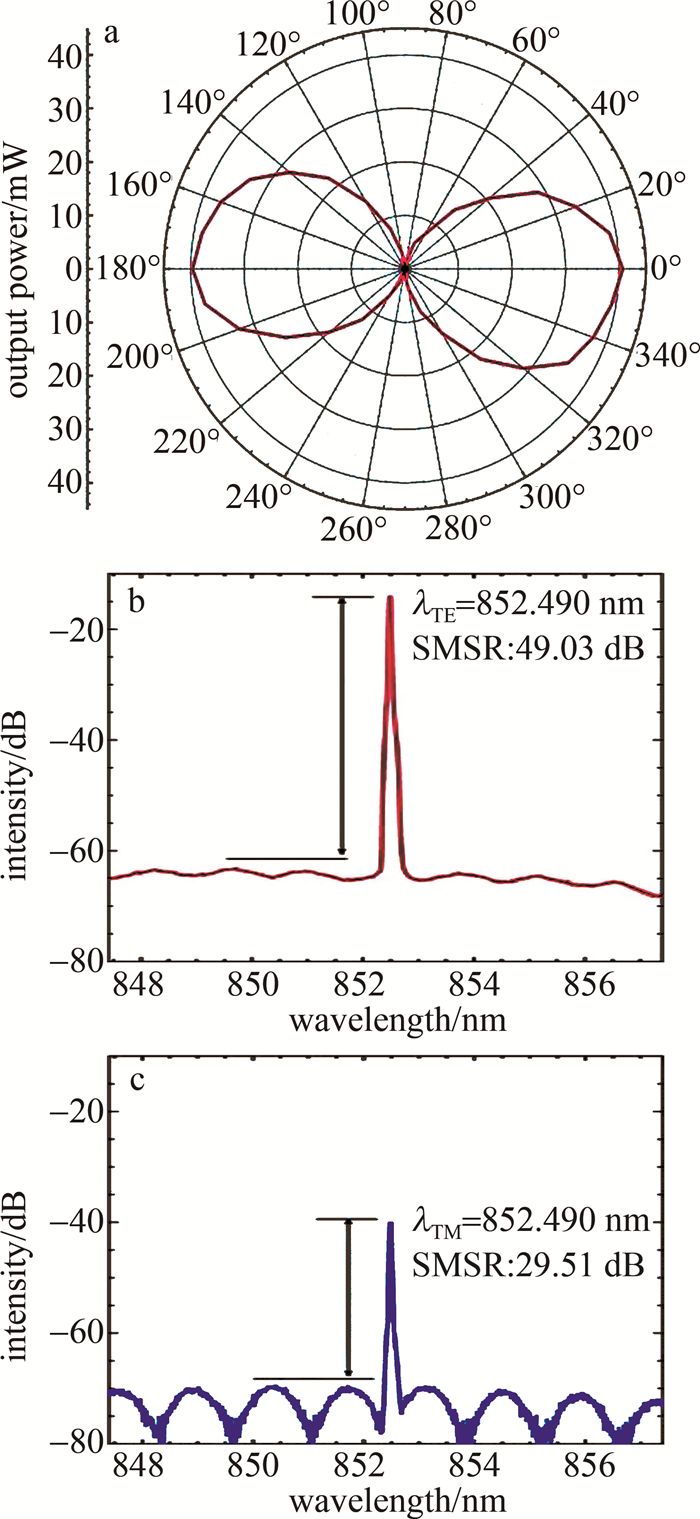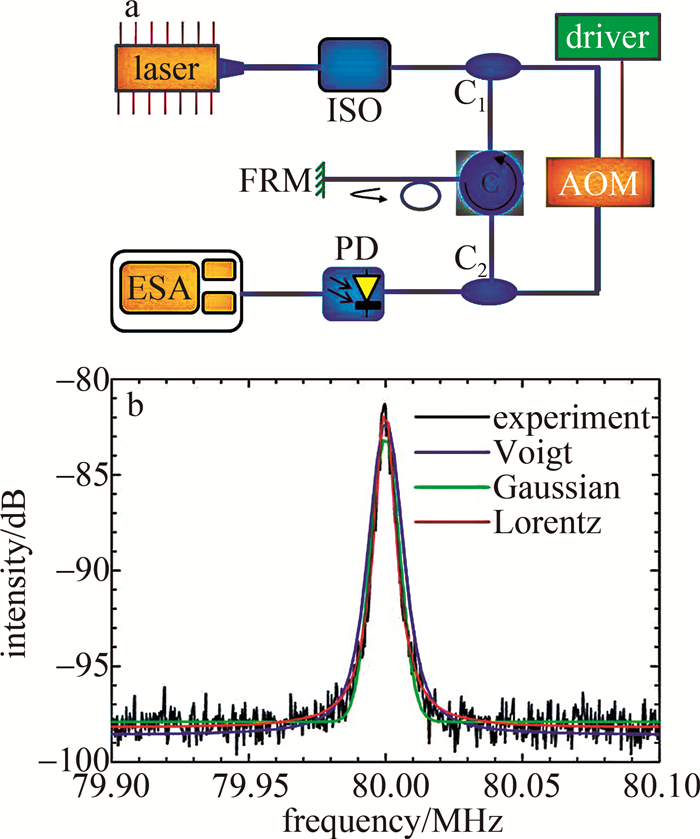Narrow linewidth semiconductor laser based on polarization maintaining Bragg grating
-
摘要: 为了研制面向量子精密测量应用的近红外波段光纤光栅外腔半导体激光器,采用独立设计的高偏振依赖增益芯片和双折射光纤布喇格光栅,通过法布里-珀罗等效谐振腔模型,系统分析了光栅反射率、外腔和芯片长度对激光线宽的影响。结果表明,所研制激光器实现了54.46 mW的输出功率、58.88 dB的边模抑制比和24.46 dB的偏振消光比,利用延迟自外差拍频方法测得的洛伦兹线宽低至2.69 kHz。此研究为独立设计制备分立器件的单频窄线宽外腔半导体激光器提供参考,有望应用于雷达成像、陀螺仪、磁力仪和原子钟等量子精密测量领域。Abstract: In order to develop a near-infrared band fiber grating external cavity semiconductor laser for quantum precision measurement applications, a high polarization dependent gain chip and a birefringent fiber Bragg grating were designed independently, the effects of grating reflectivity, external cavity, and chip length on laser linewidth were systematically analyzed based on the Fabry-Pérot equivalent resonant cavity model. The results showe that the developed laser achieves an output power of 54.46 mW, a side mode suppression ratio of 58.88 dB, and a polarization extinction ratio of 24.46 dB. The Lorentz linewidth measured is 2.69 kHz by delayed self-heterodyne beat frequency method. This study provides a reference for the single frequency narrow linewidth external cavity semiconductor lasers with independent design and preparation of discrete devices, and is expected to be used in quantum precision measurement fields such as radar imaging, gyroscopes, magnetometers, and atomic clocks.
-
-
-
[1] 徐强, 沈思, 谢修敏, 等. 可用于激光雷达的量子光学技术[J]. 激光技术, 2021, 45(1): 44-47. DOI: 10.7510/jgjs.issn.1001-3806.2021.01.008 XU Q, SHEN S, XIE X M, et al. Quantum optical techniques for laser detection and ranging[J]. Laser Technology, 2021, 45(1): 44-47(in Chinese). DOI: 10.7510/jgjs.issn.1001-3806.2021.01.008
[2] SHI H, CHANG P, WANG Z, et al. Frequency stabilization of a Cesium Faraday laser with a double-layer vapor cell as frequency reference[J]. IEEE Photonics Journal, 2022, 14(6): 1561006.
[3] CHOU C W, HUME D B, ROSENBAND T, et al. Optical clocks and relativity[J]. Science, 2010, 329(5999): 1630-1633. DOI: 10.1126/science.1192720
[4] LUVSANDAMDIN E, SPIEβBERGER S, SCHIEMANGK M, et al. Development of narrow linewidth, micro-integrated extended cavity diode lasers for quantum optics experiments in space[J]. Applied Physics, 2013, B111(2): 255-260.
[5] LUDLOW A D, ZCLCVINSKY T, CAMPBELL G K, et al. Sr lattice clock at 1×10-16 fractional uncertainty by remote optical evaluation with a Ca clock[J]. Science, 2008, 319(5871): 1805-1808. DOI: 10.1126/science.1153341
[6] HUMMON M T, KANG S, BOPP D G, et al. Photonic chip for laser stabilization to an atomic vapor with 10-11 instability[J]. Optica, 2018, 5(4): 443-449. DOI: 10.1364/OPTICA.5.000443
[7] 张建伟, 宁永强, 张星, 等. 高温工作垂直腔面发射半导体激光器现状与未来(特邀)[J]. 光子学报, 2022, 51(2): 0251201. ZHANG J W, NING Y Q, ZHANG X, et al. Development and future of vertical cavity surface emitting lasers operated at high temperatures (invited)[J]. Acta Photonica Sinica, 2022, 51(2): 0251201(in Chinese).
[8] 何幸锴, 侯辉, 冯力天, 等. 1550 nm单频脉冲光纤激光放大器实验研究[J]. 激光技术, 2011, 35(2): 145-148. DOI: 10.3969/j.issn.1001-3806.2011.02.001 HE X K, HOU H, FENG L T, et al. Experimental study of 1550 nm single frequency pulsed fiber laser amplifiers[J]. Laser Technology, 2011, 35(2): 145-148(in Chinese). DOI: 10.3969/j.issn.1001-3806.2011.02.001
[9] FABIAN M, NICOLE K, BENNO W. Stabilized laser system at 1550 nm wavelength for future gravitational-wave detectors[J]. Physical Review, 2022, D105(12): 122004.
[10] KRAKOWSKIA M, MEGHNAGIA M, AFUSO-ROXOA P, et al. Modulated DFB-ridge laser diodes at 894 nm for compact Cesium CPT atomic clocks[J]. Proceedings of the SPIE, 2023, 12440: 1244004.
[11] JIMENEZ A, MILDE T, STAACKE N, et al. Narrow-line external cavity diode laser micro-packaging in the NIR and MIR spectral range[J]. Applied Physics, 2017, B123(7): 1-14.
[12] YIM S, KIM T, CHOI J. A simple extended-cavity diode laser using a precision mirror mount[J]. Review of Scientific Instruments, 2020, 91(4): 046102. DOI: 10.1063/1.5140560
[13] 郭天华, 汪岳峰, 于广礼. 光纤光栅外腔半导体激光器理论模型分析与选取[J]. 激光技术, 2017, 41(2): 225-230. DOI: 10.7510/jgjs.issn.1001-3806.2017.02.016 GUO T H, WANG Y F, YU G L. Selection and analysis of theoretical model of fiber Bragg grating external cavity laser diode[J]. Laser Technology, 2017, 41(2): 225-230(in Chinese). DOI: 10.7510/jgjs.issn.1001-3806.2017.02.016
[14] 王直圆, 陈超, 单肖楠, 等. 光纤光栅外腔半导体激光器噪声特性仿真[J]. 激光与光电子进展, 2017, 54(1): 011401. WANG Zh Y, CHEN Ch, SHAN X N, et al. Simulation of noise characteristics of fiber grating external cavity lasers[J]. Laser and Optoelectronics Progress, 2017, 54(1): 011401(in Chinese).
[15] ZHANG L, WEI F, SUN G W, et al. Thermal tunable narrow linewidth external cavity laser with thermal enhanced FBG[J]. IEEE Photonics Technology Letters, 2017, 29(4): 385-388. DOI: 10.1109/LPT.2017.2648889
[16] PAUL A. MORTON, MICHAEL J M. High-power, ultra-low noise hybrid lasers for microwave photonics and optical sensing[J]. Journal of Lightwave Technology, 2018, 36(21): 5048-5057. DOI: 10.1109/JLT.2018.2817175
[17] HISHAM H K, ABAS A F, MAHDIRAJI G A, et al. Improving the characteristics of the modulation response for fiber Bragg grating Fabry-Perot lasers by optimizing model parameters[J]. Optics and Laser Technology, 2012, 44(6): 1698-1705. DOI: 10.1016/j.optlastec.2012.01.027
[18] HAO L, WANG X, JIA K, et al. Narrow-linewidth single-polarization fiber laser using non-polarization optics[J]. Optics Letters, 2021, 46(15): 3769-3772. DOI: 10.1364/OL.434307
[19] LUO X C, CHEN C, NING Y Q, et al. Single polarization, narrow linewidth hybrid laser based on selective polarization mode feedback[J]. Optics and Laser Technology, 2022, 154: 108340. DOI: 10.1016/j.optlastec.2022.108340
[20] HENRY C H. Theory of the linewidth of semiconductor lasers[J]. IEEE Journal of Quantum Electronics, 1982, 18(2): 259-264. DOI: 10.1109/JQE.1982.1071522
[21] MALINAUSKAS M, ŽUKAUSKAS A, HADEGAWA S, et al. Ultrafast laser processing of materials: from science to industry[J]. Light: Sciences and Applications, 2016, 5(8): e16133. DOI: 10.1038/lsa.2016.133
[22] 徐华伟, 宁永强, 曾玉刚, 等. 852 nm半导体激光器InGaAlAs, InGaAsP, InGaAs和GaAs量子阱的温度稳定性[J]. 发光学报, 2012, 33(6): 640-646. XU H W, NING Y Q, ZENG Y G, et al. Temperature stability of InGaAlAs, InGaAsP, InGaAs and GaAsquantum-wells for 852 nm laser diode[J]. Chinese Journal of Luminescence, 2012, 33(6): 640-646(in Chinese).
[23] VERMERSCH F J, LIGERET V, BANSROPUN S, et al. High-power narrow linewidth distributed feedback lasers with an Aluminium-free active region emitting at 852 nm[J]. IEEE Photonics Technology Letters, 2008, 20(13): 1145-1147. DOI: 10.1109/LPT.2008.924903
[24] LUO X C, CHEN C, NING Y Q, et al. High linear polarization, narrow linewidth hybrid semiconductor laser with an external birefringence waveguide Bragg grating[J]. Optics Express, 2021, 29(21): 33109-33120. DOI: 10.1364/OE.431341
[25] WANG Y, TAI H, DUAN R, et al. Super-gain nanostructure with self-assembled well-wire complex energy-band engineering for high performance of tunable laser diodes[J]. Nanophotonics, 2023, 12(9): 1763-1776. DOI: 10.1515/nanoph-2023-0013
[26] WANG Z, KE C, ZHONG Y, et al. Ultra-narrow-linewidth measurement utilizing dual parameter acquisition through a partially coherent light interference[J]. Optics Express, 2020, 28(6): 8484-8493. DOI: 10.1364/OE.387398
[27] CANAGASABEY A, MICHIE A, CANNING J, et al. A comparison of Michelson and Mach-Zehnder interferometers for laser linewidth measurements[C]//2011 International Quantum Electronics Conference (IQEC) and Conference on Lasers and Electro-Optics (CLEO) Pacific Rim. New York, USA: IEEE Press, 2011: 1392-1394.
[28] CHEN M, MENG Z, WANG J F, et al. Ultra-narrow linewidth measurement based on Voigt profile fitting[J]. Optics Express, 2015, 23(5): 6803-6808. DOI: 10.1364/OE.23.006803




 下载:
下载:

